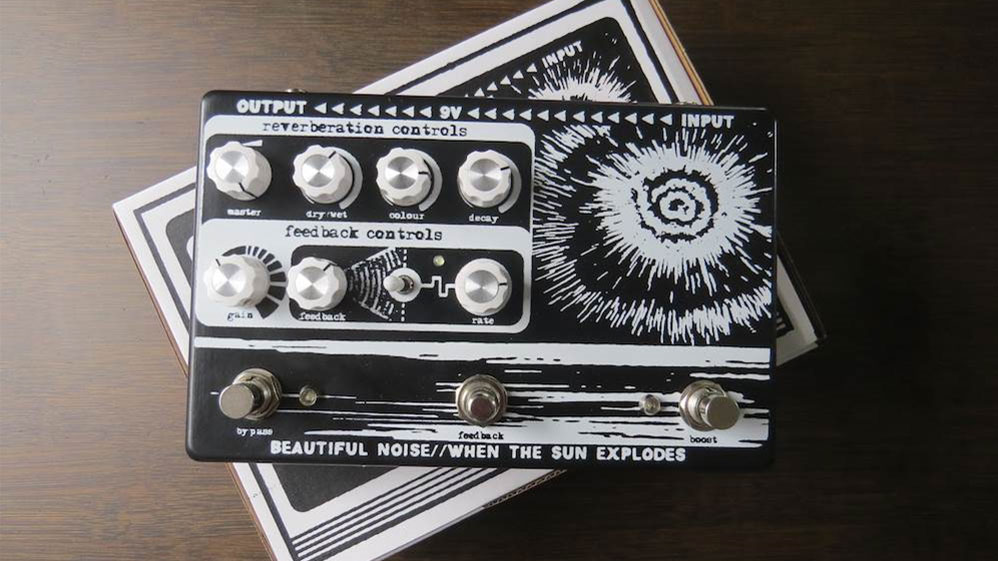Guitar World Verdict
Nick Raffaele has created a truly wonderful reverb unit with enough of a twist to see himself eventually secure a foothold in the already burgeoning hand-built pedal market in Australia.
Pros
- +
Versatility
- +
It inspires play
Cons
- -
No battery
- -
Large footprint
You can trust Guitar World
When The Sun Explodes is the first offering from Nick Raffaele of Beautiful Noise, a boutique pedal builder from Newcastle, NSW. Raffaele has built a small, yet dedicated following in the steel city, slinging custom jobs and reinterpretations of classic pedals with his own twist. When The Sun Explodes is just that: a homage to his love of the different. Growing up in Tamworth – Australia’s capital of country music – seems to have sparked Raffaele’s fondness for the absurd. Upon unboxing the pedal, we see that it’s visually drenched in post-apocalyptic imagery with an exploding sun and nuclear fallout waves stamping its design. The whole piece is finished off with a tasteful black enclosure contrasted with white knobs.
The layout features seven knobs and three switches, which seems a little daunting at first. But with relative ease, I quickly found a warm and spring-like reverb not unlike that of Fender amps. Once I got comfortable and I started to explore what this thing has to offer, its true value quickly became known. The manual is Spartan, written simply and clear – it’s straight to the point and explains this mammoth pedal and its features well.
The Master knob is an output volume control, and the pedal operates best in this mode. The Dry/Wet knob affects the amount of reverb signal you get – turning it counter-clockwise will give you less, and vice versa. The Colour knob is a tone control that reigns over both aspects of the pedal – the feedback and the regular reverb circuit. The Decay knob affects the amount of tail delivered to the reverb.
Gain works as a distortion control on the output signal of the pedal. Turning it up halfway gives us a clean overdrive, but anything over leads to a wall of fuzzy mess. Feedback controls the amount of reverb going through the looper –
the wetter the reverb, the more extreme this pedal gets. Finally, we have a dipswitch that toggles the LFO tremolo on and off, and a Rate knob that controls the speed of the tremolo.
Switch it up
The Bypass switch is a simple on/off affair. The Feedback switch is a momentary switch that allows you to create walls of drenched reverb tails and let them dissipate as soon as your foot is off the pedal. The boost switch is what made this pedal really stand out to me: engaging it instantly doubles the signal, giving a warm and swampy, almost slapback delay sound. By combining the features of the dry/wet signal and adjusting to a short decay time, you can easily achieve a classic rockabilly tape echo. Alternatively, by rocking on the feedback switch, you can control an instantaneous wall of noise.
Having a tone knob on a reverb is a blessing in disguise; it’s the kind of thing that you never realise you’re missing until the obvious is directly in front of you. By turning the knob clockwise, you get a glassy, brittle chime that instantly calls for country licks and high-energy chord voicings. If the song calls for somber voicings and a darker tone, just dial it back for a more brooding reverb tone.
In curious exploration, I discovered that if you turn all the reverb craziness down and just use the gain and master settings, you’ll end up with a really fizzy and transparent overdrive at your disposal. It’s a nice little option to have.
All the latest guitar news, interviews, lessons, reviews, deals and more, direct to your inbox!
The elephant blocking the sun
This pedal is big – about the size of those in the Boss DD line, which may be a problem for some seeking real estate value for their pedalboard. But that shouldn’t be the case: I see it as a pedal you shape your board around – it belongs at the front of your board, ready to use on a whim in a burst of creativity, in a solo or to fatten a rhythm with the boost switch.
I also noticed a lack of a battery compartment, but that’s hardly a negative these days with more and more companies opting out of adding battery compartments anyway. I was pleased to find that there were no signal loss or noise floor issues when I tested it on all of my different power supplies, including a board supply.
The bottom line
Nick Raffaele has created a truly wonderful reverb unit with enough of a twist to see himself eventually secure a foothold in the already burgeoning hand-built pedal market in Australia. The amount of variety in When The Sun Explodes sets a benchmark for what is capable in the market. Raffaele takes seemingly familiar items and makes them seem fresh and new with features that unlock a player’s creativity and allow them to explore music from a different point of view. We eagerly await his future releases, but for now, When The Sun Explodes is a stunning debut.

